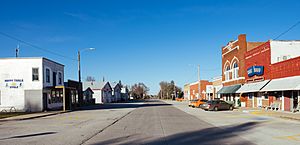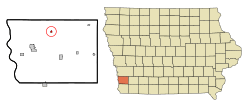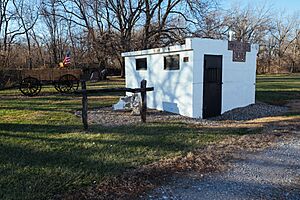Silver City, Iowa facts for kids
Quick facts for kids
Silver City, Iowa
|
|
|---|---|
 |
|

Location of Silver City, Iowa
|
|
| Country | |
| State | |
| County | Mills |
| Area | |
| • Total | 0.21 sq mi (0.54 km2) |
| • Land | 0.21 sq mi (0.54 km2) |
| • Water | 0.00 sq mi (0.00 km2) |
| Elevation | 1,047 ft (319 m) |
| Population
(2020)
|
|
| • Total | 245 |
| • Density | 1,172.25/sq mi (452.03/km2) |
| Time zone | UTC-6 (Central (CST)) |
| • Summer (DST) | UTC-5 (CDT) |
| ZIP code |
51571
|
| Area code(s) | 712 |
| FIPS code | 19-73155 |
| GNIS feature ID | 0461609 |
Silver City is a small city located in Mills County, Iowa, in the United States. In 2020, about 245 people lived there. A special path called the Wabash Trace goes through Silver City. This path used to be a railroad, but now it's a popular trail for bikes. Along the trail, you can find a small park with a gazebo and a cozy cafe.
Contents
A Look at Silver City's Past
Silver City began in 1879. It started when the Wabash, St. Louis and Pacific Railway built its tracks through the area.
During its busiest times, Silver City was a lively place. It had many businesses, like a lumber yard, a grocery store, and even a jewelry store. There was also a horse racing track and a pharmacy. An annual carnival would visit the town, bringing lots of fun.
Today, Silver City is home to the Loyal Lassies/Ingraham Straight Shooters 4-H club. It also has the Silver City Library and a historical society. The Silver City Volunteer Fire & Rescue team helps keep the town safe. The Mills County Sheriffs Department also provides emergency help and patrols the area.
Where is Silver City Located?
Silver City is found at coordinates 41.112051 degrees North and -95.638057 degrees West. The town's name comes from Silver Creek, which flows near its eastern edge. This creek is a small branch of the West Nishnabotna River.
The Wabash Trace Nature Trail, which used to be a railway line, enters the town from the west. It then runs southeast through Silver City before turning south and meeting Silver Creek.
According to the United States Census Bureau, Silver City covers about 0.22 square miles (0.54 square kilometers) of land. There is no water area within the city limits.
Who Lives in Silver City?
| Historical populations | ||
|---|---|---|
| Year | Pop. | ±% |
| 1880 | 185 | — |
| 1890 | 324 | +75.1% |
| 1900 | 438 | +35.2% |
| 1910 | 416 | −5.0% |
| 1920 | 430 | +3.4% |
| 1930 | 355 | −17.4% |
| 1940 | 346 | −2.5% |
| 1950 | 311 | −10.1% |
| 1960 | 281 | −9.6% |
| 1970 | 272 | −3.2% |
| 1980 | 291 | +7.0% |
| 1990 | 252 | −13.4% |
| 2000 | 259 | +2.8% |
| 2010 | 245 | −5.4% |
| 2020 | 245 | +0.0% |
| Source: and Iowa Data Center Source: |
||
Population in 2020
In 2020, the census showed that 245 people lived in Silver City. There were 101 households and 71 families. The city had about 1,170 people per square mile. Most residents, about 91.8%, were White. A small number, 1.6%, were Hispanic or Latino.
About 31.7% of the households had children under 18 living with them. The average age in the city was 44.4 years old. About 25.3% of the people were under 20 years old. Also, 22.0% were 65 years old or older. The population was almost evenly split between males (52.7%) and females (47.3%).
Population in 2010
The census in 2010 also counted 245 people living in Silver City. There were 104 households and 79 families. Most people, 95.9%, were White. About 1.2% were Hispanic or Latino.
About 26.9% of households had children under 18. The average age was 45.3 years. About 19.6% of residents were under 18. And 16.7% were 65 or older. The gender split was similar to 2020, with 52.7% male and 47.3% female.
Schools in Silver City
The city of Silver City is part of the Glenwood Community School District. This means students in Silver City attend schools within this district.
See also
 In Spanish: Silver City (Iowa) para niños
In Spanish: Silver City (Iowa) para niños


